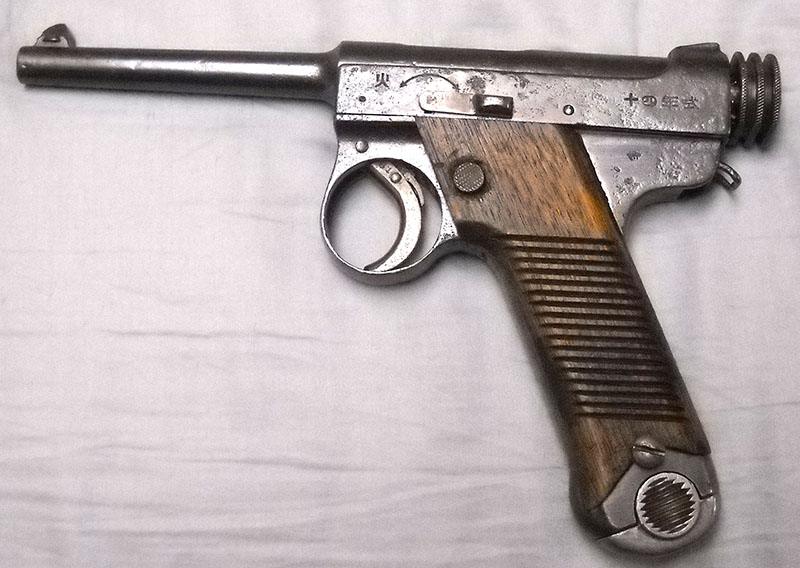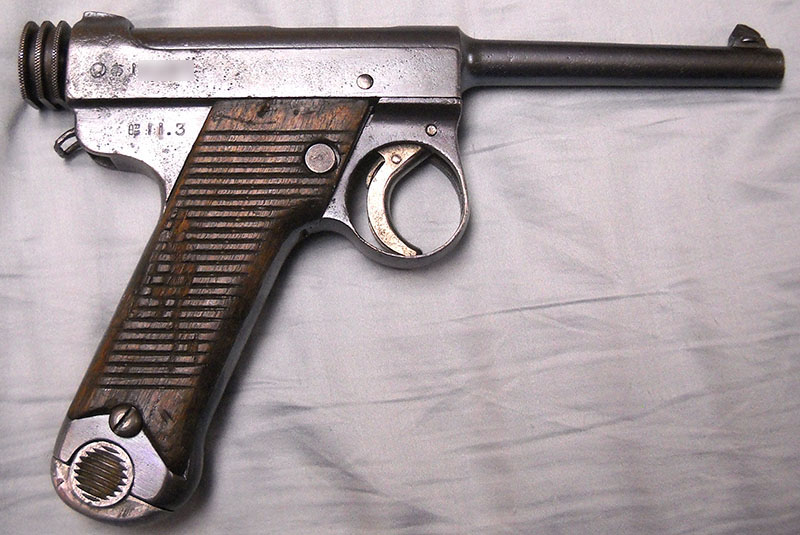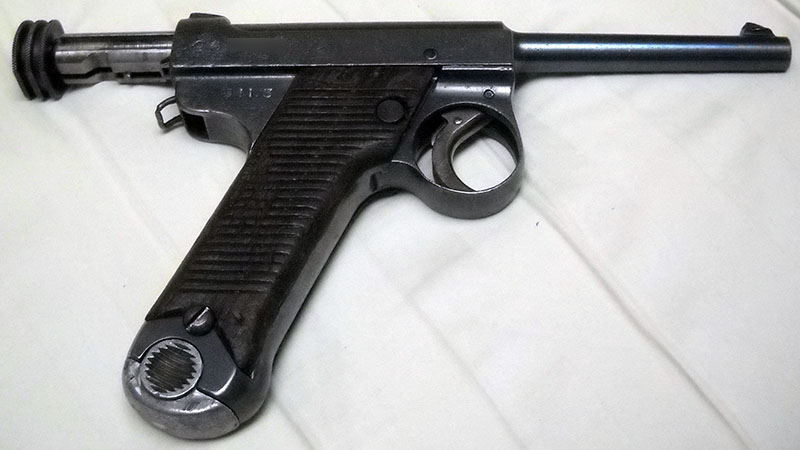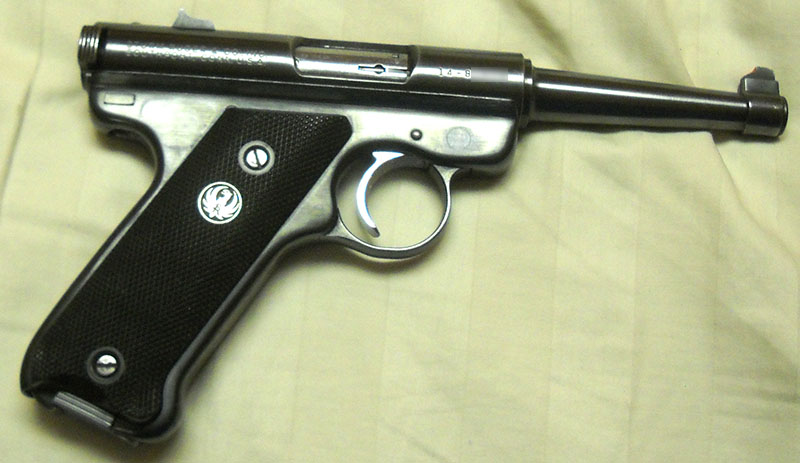

Originally posted November 22, 2015.

Here we have a Nambu Type 14, or, to give it its more formal name, the Year 14 Type pistol, designed by Lieutenant-General Kijirō Nambu (1869-1949). This was the official sidearm of the Imperial Japanese Army from 1925 to 1945 (when the IJA ceased to exist with Japan's defeat in World War II). It's called the Year 14 Type because 1925, the year of its adoption, was the 14th (and, as it turned out, final) year of the reign of Emperor Taishō.
The Type 14 evolved from a series of automatic pistols Nambu designed, all of which looked much like it and operated along similar mechanical principles. The Nambu pistols were Japan's first domestic self-loading handguns, and were popular with Nambu's fellow military officers well before the version that became the Type 14 was adopted. Most were full-sized and chambered for the 8mm Nambu cartridge, though there was also a compact 7mm version available on the commercial market (nicknamed "Baby Nambu" by modern Western collectors, by analogy with the 7.65mm compact "Baby Luger").

The one shown is not the final version of the Type 14, which continued to evolve throughout its service life. This particular one was manufactured in the third month of the 11th year of the reign of Emperor Shōwa - that is, March of 1936. You can see the production date on the right side of the gun, on the frame just behind the grip panel. The Japanese symbol is "Sho", short for Shōwa, and then "11.3" means just what it seems like it ought to mean. The longer number above that, on the side of the receiver, is the serial number. The figures before the digits indicate that this example was made by General Nambu's own factory (he went into the manufacturing business after retiring from the Army in 1924), under contract to the Nagoya Arsenal (the leftmost symbol is their insignia).

In this shot you can see more clearly that although the barrel and bolt housing do reciprocate slightly (because it's a short-recoil action), the Nambu doesn't have a slide in the "traditional" semiautomatic pistol sense; instead, the bolt moving inside the rear housing is the main moving part.
A later revision of the Nambu, which started appearing later in the '30s, has a distinctive enlarged trigger guard, which was supposedly adopted after Japanese troops serving in Manchuria complained that it was hard to operate the original version (shown above) with gloves on. Unsurprisingly, wartime production models show declining manufacturing quality, becoming progressively cruder and with certain mechanically nonessential features simplified or omitted. For instance, late-war Nambus often have a solid knob at the back of the bolt instead of the elaborately slotted version seen above. On very late ones that knob may not even be knurled, which must make those examples interesting to operate, since that's the part you pull on to operate the action.

Here's a top view of the open action. The Nambu is also unusual in that the ejection port is on the top, not the right side as is far more customary for semiautos. That's convenient for us, because it means from here you can see the top of the magazine and magazine follower. The follower is actually the only thing holding the action open. In most (but not all) semiautos that have last-round hold-opens, the follower triggers a mechanism inside the gun that holds the slide until released, but that mechanism is not actually dependent on the follower's continued presence to keep working. This is so the shooter can replace the magazine with a loaded one and then release the action, chambering the next round; it makes reloading quicker and more efficient.
The Nambu's doesn't work that way; because the magazine follower itself is the only hold-open mechanism, when you remove the empty magazine, the bolt automatically closes on the empty chamber. Once a fresh magazine is in place, the shooter must pull back and release the cocking knob manually to charge the pistol and ready it to fire again. I'm not sure why General Nambu thought that was a useful feature; perhaps it was merely intended to alert the shooter that he'd run out of ammunition and so avoid an inadvertent dry fire. The Nambu should never be dry-fired; its fragile striker is a notorious weakness of the design.
(As an aside, the rough finish on the example pictured isn't because of straitened manufacturing circumstances - it was made in 1936, well before the standards started being lowered. It's just had a hard life; what collectors call a "beater". As an aside to the aside, "Beater Nambu" is my Japanese action cinema screen name.)
As an unusual, visually distinctive handgun, the Nambu is highly recognizable in screen appearances, though because of its grip angle and association with the Axis powers, many laypeople mistake them for Lugers. It has to be admitted, though, that they weren't terribly effective firearms. The 8mm Nambu cartridge is not very powerful (it's been compared to 7.65mm Browning/.32 ACP,¹ which, though I certainly wouldn't want to get shot with one, is often slagged off by modern gun writers as Unsuitable for Defense), and apart from its very nice, natural-pointing grip angle, the weapon is a bit awkward to handle. The safety, for instance, has to be operated with the off hand. (It's that big lever on the left side; it has to be turned a complete 180° to engage or disengage.) The sights are also pretty poor.
Then again, both of those features are of its time. 7.65mm used to be a quite highly regarded defensive cartridge. Hell, in 1957 James Bond author Ian Fleming, on the advice of a fan letter from a firearms expert, outfitted 007 with a 7.65mm Walther PPK specifically because it was held to be a manstopper ("delivery like a brick through a plate glass window," as Major Boothroyd says in the 1962 film version of Doctor No). There's a whole raft of 7.65/.32 pistols from the early-to-mid-1900s; police sidearms, in particular, used to use the cartridge quite regularly. That's what the Walther PP/PPK was designed for, in fact.
So in that regard, the Nambu is really only lacking if one holds military handguns to a higher power standard than police ones, which pretty much only Americans did in the 1940s. The Japanese simply didn't regard the sidearm as terribly important militarily, and so weren't that bothered that their used a relatively wimpy cartridge. And anyway, as I say, I certainly wouldn't want to get shot with one. Not that I'm very likely to, since 8mm Nambu ammunition is hard to find and pretty expensive when you do find it.
As for the sights, well, they're not great, but on the other hand, in the early 20th century few handguns had sights that were better than barely adequate, and many had sights that weren't. Or didn't have them at all.
Anyway, the Type 14. It is what it is, and in the context of its time it's pretty impressive. Not terribly powerful nor particularly accurate, but it's a fully developed, reliably functional self-loading handgun that came at a time when such things were, for the most part, only made by industrial nations of the first rank. This is particularly impressive when you consider that Japan only began properly industrializing after its forcible "opening" to the West in 1854 - 50 years before the earliest Nambu models hit the market and 70 before the adoption of the Type 14 as the IJA's standard-issue sidearm. That is a pretty significant technological achievement. Britain, Japan's great role model and rival in the fields of military and naval technology, didn't adopt a self-loading army sidearm until the 1950s! But that's another post.
The Type 14 is also the indirect ancestor of the Ruger Standard family of .22-caliber pistols, which debuted in 1949. Bill Ruger's original idea was to make and sell reproduction Nambus, having acquired one from a returning GI after WWII, but after making a couple of copies in his garage, he decided to simplify the design and make a straight-blowback rimfire pistol instead. You can still see the resemblance, particularly in the grip geometry and the way the bolt is configured.

Of note is the fact that, although the Ruger is a simple blowback and not a short-recoil-operated semiauto like the Nambu, and therefore the barrel does not move when firing, the barrel and bolt shroud assembly is still a separate piece that can be removed (admittedly with great difficulty, in the Mk I through Mk III Rugers) for cleaning.
I should note at this point that the Type 14 Nambu is not the Nambu pistol that is famously so unsafe that it will occasionally shoot its owner out of pure spite. That's the Type 94. (Seriously, it has an external trigger mechanism, so you can fire it by pressing a spot on the side of the gun that has nothing evident to do with the trigger. This would reportedly sometimes happen to, for instance, airmen or tank crewmen who were daft enough to take the flagrant and provocative action of loading it, holstering it, and then sitting down.) A properly functioning Type 14 is not dangerous to its operator under normal conditions.
--G.
¹ Two different names for the same cartridge; it was called 7.65mm Browning in Europe and .32 Automatic Colt Pistol in the USA, because Colt sold John Browning's designs under its own name over here.